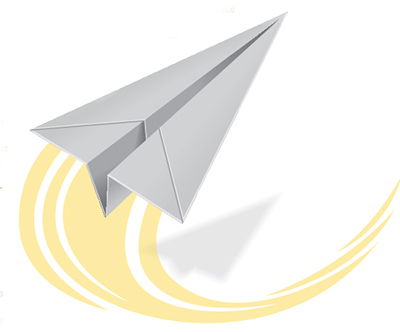Day Two Experiment
on August 1, 2019Make Your Own Paper Airplane

Materials (per group)
- Variety of paper types: copier paper, construction paper, card stock
- Paper airplane patterns—print several according to the ability levels of your children from http://www.foldnfly.com
- Measuring tape
- Masking tape
- Crayons
- Optional: world map and toy hoops
- Babel Legend cards (download below), 1 per child
Class Time Directions
Today, at The Incredible Race, we’re learning about the roadblock that happened at the tower of Babel, when God confused the language of the people, causing them to spread out over the earth. This happened about 4,000 years ago. How do you think the people began to move to different parts of the earth? Wait for answers: boats, walking, riding animals. Do you think any of them used an airplane? Wait for answers. It’s not very likely, is it? The airplane was invented rather recently and wasn’t around during the tower of Babel times.
The inventors of the first powered flight in an airplane were two brothers named Orville and Wilbur Wright. The Wright brothers grew up knowing God and enjoyed studying his creation. They examined how birds fly, the shape of their wings and bodies, and how their wings change shape as they fly. They used that knowledge to design and build a machine that would fly. In December of 1903, after many years of experimentation on wing shape and propellers and how to make it go, Orville Wright flew their plane a distance of about 120 feet (explain how far this would be using something in your area), staying in the air for 12 seconds. Later that day, Wilbur flew about 852 feet and stayed in the air for 59 seconds. The name of their first plane was the Wright Flyer.
There are four forces that operate on an airplane to keep it flying through the sky. The one we’re most familiar with is the one that keeps us on the ground. Do you know what it is? Take responses. Gravity. God made this law in the beginning and because God never changes, the laws he makes never change. Because of the force of gravity, we know that tomorrow we won’t wake up and fly off into the sky. God made the force of gravity and it doesn’t change! So the weight of the plane pulls the plane down toward the earth because of gravity, and this is one of the forces.
Do you know what we call the opposite force from gravity? Show a lifting motion with your hands and take responses. Lift. This force pulls the airplane up in the air.
Do you know what the force is called that makes the airplane move forward? Thrust. Your arm gives a paper airplane thrust when you push it through the air. In a real airplane, the engines thrust the plane forward.
And the force that balances thrust is drag. Drag is what helps to slow down the plane when it needs to land.
Today, you’re going to design and build an airplane out of paper!
Pass out the pieces of paper and the patterns. They can experiment with different paper types and shapes. Younger children will require more help with making their airplanes. Older children can follow the patterns themselves. They can color them and name them, if they want to. Students can make and design as many planes as you have time and paper for.
Experiment with how far they fly and how long they stay in the air. Place a piece of masking tape on the floor and stretch out the measuring tape. They can stand at the masking tape and toss their airplanes to see how far they go. Use a stopwatch to time their flights. Or, to make it a little more challenging, hang a world map a distance away and see if they can hit the continent of the day—Asia. Or, you can suspend toy hoops at differing heights and see if they can get their planes through the various targets. Make the targets worth different points.
Although the people at the time of the tower of Babel didn’t have airplanes, today we can use airplanes to help bring the good news of Jesus to people who ended up in faraway places after the families moved apart.
Pass out the Babel Legend cards, 1 per child.
Tip Corner
- One test church walked the kids step-by-step through three basic airplane designs, putting the illustrated steps on a projection screen. The first they called the Basic, the second the Dart, and the third the Stable. Each began with the same basic folds but then had different folds to complete it.
- Remember to put names on the planes after completion to identify and retrieve.
Related Downloads
Babel Legends! Cards
PDF DownloadIncredible Race World Class Science & Crafts (Excerpt)
Kids love science experiments and crafts! This guide contains everything you need to coordinate the daily science experiments and crafts for all age groups.
Browse Kids Book- © 2024 Answers in Genesis
- Privacy Policy
- Contact
- About

